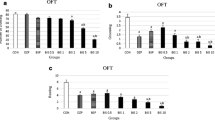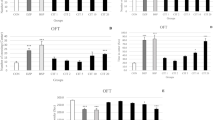Abstract
In earlier research, we have hypothesized that exposure to nitrous oxide (N2O) produces an anxiolytic effect that is mediated by benzodiazepine (BZ) receptors. The present research was conducted to characterize pharmacologically the behavioral effects of N2O in comparison with a BZ standard, chlordiazepoxide (CP), in the mouse elevated plus maze. Exposure to increasing levels of N2O produced a concentration-related increase in the percent of total entries into and the percent of total time spent on the open arms, a pattern of response similar to that induced by CP. These effects of N2O and CP were both antagonized by pretreatment with the BZ receptor blocker flumazenil (FLU). In another experiment, mice made tolerant to CP also exhibited a cross-tolerance to N2O. These results support the hypothesis that the anxiolytic effect of N2O is mediated by BZ receptors.
Similar content being viewed by others
References
Allen GD (1979) Postgraduate dental handbook series, vol. 1. Dental analgesia. PSG, Littleton
Allen GD (1984) Dental anesthesia and analgesia (local and general), 3rd edn. Williams and Wilkins, Baltimore
Atkinson RM, Green JD, Chenoweth DE, Atkinson JH (1979) Subjective effects of nitrous oxide: cognitive, emotional, perceptual and transcendental experiences. J Psychedelic Drugs 11:317–330
Barber J, Donaldson D, Ramras S, Allen GD (1979) The relationship between nitrous oxide conscious sedation and the hypnotic state. J Am Dent Assoc 99:624–626
Berkowitz BA, Ngai SH, Finck AD (1976) Nitrous oxide “analgesia”: resemblance to opiate action. Science 194:967–968
Berkowitz BA, Finck AD, Ngai SH (1977) Nitrous oxide analgesia: reversal by naloxone and development of tolerance. J Pharmacol Exp Ther 203:539–547
Brodsky L, Zuniga J (1975) Nitrous oxide: a psychotogenic agent. Comp Psychiatry 16:185–188
Czech DA, Green DA (1992) Anxiolytic effects of nitrous oxide in mice in the light-dark and holeboard exploratory tests. Psychopharmacology 109:315–320
Czech DA, Quock RM (1993) Nitrous oxide induces an anxiolytic effect in the conditioned defensive burying paradigm, which can be reversed with a benzodiazepine receptor blocker. Psychopharmacology 113:211–216
Daras C, Cantril RC, Gillman MA (1983) [3H]Naloxone displacement: evidence for nitrous oxide as opioid receptor agonist. Eur J Pharmacol 89:177–178
Emmanouil DE, Quock RM (1990) Effects of benzodiazepine agonist, inverse agonist and antagonist drugs in the mouse staircase test. Psychopharmacology 102:95–97
Emmanouil DE, Quock RM (1991) Possible involvement of benzodiazepine receptors in the anxiolytic effect of nitrous oxide in the elevated plus maze. Third IBRO World Congr Neurosci Abstracts. Pergamon, New York p 211
File SE, Pellow S (1985) The anxiogenic action of RO 5-4864 in the social interaction test: effect of chlordiazepoxide, RO 15-1788 and CGS 8216. Naunyn-Schmiedeberg's Arch Pharmacol 328:225–228
Finck AD (1985) Nitrous oxide analgesia. In: Eger EI (ed) Nitrous Oxide/N2O. Elsevier, New York, pp 41–55
Gillman MA (1986) Analgesic (subanesthetic) nitrous oxide interacts with the endogenous opioid system: a review of the evidence. Life Sci 39:1209–1221
Hynes MD, Berkowitz BA (1979) Nitrous oxide stimulation of locomotor activity: evidence for an opiate-like behavioral effect. J Pharmacol Exp Ther 209:304–308
Hynes MD, Berkowitz BA (1982) Lack of an opiate response to nitrous oxide in mice resistant to the activity-stimulating effects of morphine. J Pharmacol Exp Ther 220:499–503
Hynes MD, Berkowitz BA (1983) Catecholamine mechanisms in the stimulation of mouse locomotor activity by nitrous oxide and morphine. Eur J Pharmacol 90:109–114
Johnson C, Emmanouil DE, Quock RM (1992) Nitrous oxide anxiolytic effect in mice in the elevated plus maze: antagonism by flumazenil and cross-tolerance with benzodiazepines. Pharmacologist 34:137
Langa H (1976) Relative analgesia in dental practice—inhalation analgesia with nitrous oxide. Saunders, Philadelphia
Lee C, Rodgers RJ (1991) Effects of benzodiazepine receptor antagonist, flumazenil, on antinociceptive and behavioural responses to the elevated plus-maze in mice. Neuropharmacology 30:1263–1267
Lister RG (1987) The use of a plus-maze to measure anxiety in the mouse. Psychopharmacology 92:180–185
Pellow S, File SE (1986) Anxiolytic and anxiogenic drug effects on exploratory activity in an elevated plus-maze: a novel test of anxiety in the rat. Pharmacol Biochem Behav 24:525–529
Pellow S, Chopin P, File SE, Briley M (1985) Validation of open: closed arm entries in an elevated plus-maze as a measure of anxiety in the rat. J Neurosci Methods 14:149–167
Quock RM, Graczak LM (1988) Influence of narcotic antagonist drugs upon nitrous oxide analgesia in mice. Brain Res 440:35–41
Quock RM, Mueller J (1991) Protection by U-50,488H againstβ-chlornaltrexamine antagonism of nitrous oxide antinociception in mice. Brain Res 549:162–164
Quock RM, Nguyen E (1992) Possible involvement of nitric oxide in chlordiazepoxide-induced anxiolysis in mice. Life Sci 51:PL255-PL260
Quock RM, Kouchich FJ, Tseng LF (1985) Does nitrous oxide induce release of brain opioid peptides? Pharmacology 30:95–99
Quock RM, Wojcechowskyj JA, Emmanouil DE (1987) Comparison of nitrous oxide, morphine and diazepam effects in the mouse staircase test. Psychopharmacology 92:324–326
Quock RM, Best JA, Chen DC, Vaughn LK, Portoghese PS, Takemori AE (1990) Mediation of nitrous oxide analgesia in mice by spinal and supraspinalκ-opioid receptors. Eur J Pharmacol 175:97–100; Corrigendum 187:564
Quock RM, Emmanouil DE, Vaughn LK, Pruhs RJ (1992) Benzodiazepine receptor mediation of behavioral effects of nitrous oxide in mice. Psychopharmacology 107:310–314
Quock RM, Wetzel PJ, Maillefer PH, Hodges BL, Curtis BA, Czech DA (1993) Benzodiazepine receptor-mediated behavioral effects of nitrous oxide in the rat social interaction test. Pharmacol Biochem Behav 46:161–165
Russell RW, Steinberg H (1955) Effects of nitrous oxide on reactions to “stress”. Q J Exp Psychol 7:67–73
Simiand J, Keane E, Moore M (1984) The staircase test in mice: a simple and efficient procedure for primary screening of anxiolytic agents. Psychopharmacology 84:48–53
Steinberg H (1954) Effects of nitrous oxide on reactions to stress. Bull Br Psychol Soc 24:12
Steinberg H (1956) “Abnormal behaviours” induced by nitrous oxide. Br J Psychol 47:183–194
Sundin RH, Adriani J, Alam S, Butler J, Hatrel P, Hyde P, Mangum F, Nicoletti J, Wallace J (1981) Anxiolytic effects of low dosage nitrous oxide-oxygen mixtures administered continuously in apprehensive patients. South Med J 74:1489–1492
Thiebot MH, Soubrie P, Simon P, Boissier JR (1973) Dissociation de deux composantes du comportement chez de rat soul effet de psychotropes. Application a l'etude des anxiolytiques. Psychopharmacologie 31:77–90
Thiebot MH, Soubrie P, Simon P, Boissier JR (1976) Specificité d'action des tranquillisants mineurs dans de le test de l'escalier relation entre ces effets et leurs proprietes anxiolyteques. J Pharmacol (Paris) 7:87–102
Zuniga JR, Joseph SA, Knigge KM (1987) The effects of nitrous oxide on the secretory activity of pro-opiomelanocortin peptides from basal hypothalamic cells attached to cytodex beads in a superfusion in vitro system. Brain Res 420:66–72
Author information
Authors and Affiliations
Rights and permissions
About this article
Cite this article
Emmanouil, D.E., Johnson, C.H. & Quock, R.M. Nitrous oxide anxiolytic effect in mice in the elevated plus maze: Mediation by benzodiazepine receptors. Psychopharmacology 115, 167–172 (1994). https://doi.org/10.1007/BF02244768
Received:
Revised:
Issue Date:
DOI: https://doi.org/10.1007/BF02244768




